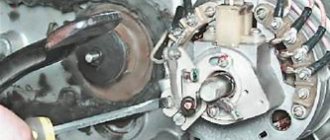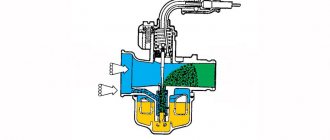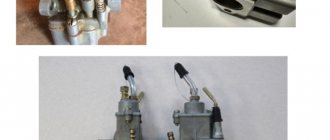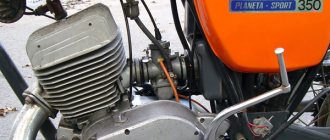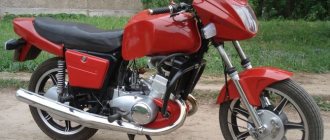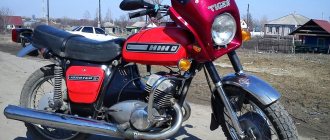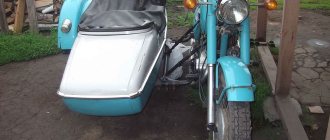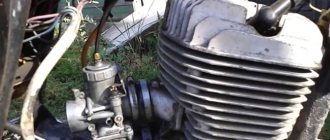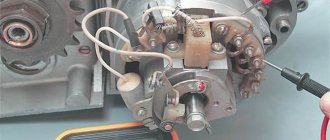In the Soviet Union, motorcycles of their own production were especially in demand and popular, so some factories produced several models that later became legends. One of them is Izh Planet Sport.
The model was positioned as a Soviet sports motorcycle with excellent technical characteristics. While the USSR was conquering Java motorcycles produced in the Czech Republic, Izh Planet Sport was gaining momentum, becoming an excellent competitor to Java. This sports horse was produced from 1873 to 1984, and during this time the Izhmash plant produced more than one thousand models that have survived to this day.
Pros:
- one of the fastest Soviet motorcycles;
- stylish appearance;
- light weight;
- convenient stand;
- Versatile and comfortable fit.
Minuses:
- not suitable as a first motorcycle;
- has a lot of noise;
- push-pull system
- There are problems with the front brake.
Background of IZh motorcycles
The entire family of IZh motorcycles traces its ancestry directly to the pre-war German model of the DKW company - NZ-350. During the Great Patriotic War, this reliable equipment became one of the main types of Wehrmacht motorcycles in the off-road conditions of the Eastern Front. In 1944, one of the DKW factories in the city of Zschopau found itself in the zone of occupation by Soviet troops. As reparation, equipment, technical documentation and specialists were exported from Germany. After the end of hostilities, the USSR government decided to begin production of Soviet motorcycles at the Izhevsk plant, which had previously produced weapons. So in Udmurtia they began to make copies of German motorcycles under the IZh brand. And these motorcycles are not inferior to their German “parents”. IZH Planet 3, as well as its modifications, as well as the following models 4 and 5, are in constant demand.
Engine Izh Planet Sport
As you know, the Izhmash plant also produced other models of the planet, but at that time they all had weak characteristics. Planet Sport became the most powerful planet at that time, receiving 349 cm3. volume and 32 horses. The only part taken from foreigners was the Mikuni carburetor, which belonged to Japanese engineers. Soon they took more electrical equipment and optics from them. As a result, with such strong characteristics and a weight of 135 kg, the planet received 237 hp. per 1 ton of weight. The result was excellent dynamic performance - the motorcycle reached 100 km/h in just 11 seconds. Soon the new modifications were significantly changed; the manufacturer decided to abandon imported elements and installed a Soviet speedometer and electrical equipment. There was also a modification with a K-62M carburetor of our own production, but with it the motorcycle produced only 28 hp.
Technical characteristics of Izh Planet Sport
Over the entire production period, the manufacturer tried to make the motorcycle as good as possible, so it was regularly upgraded. Thus, the Izh Planet Sport motorcycle has different characteristics, but the main parts remain unchanged.
The main length of the motorcycle was 207 cm, the width, depending on the modification, was from 79 to 81 cm, and the height was the same everywhere - 91 cm. The motorcycle received an excellent engine, which sometimes produces excellent dynamic data. With only 1 cylinder and operating in 2-stroke mode, Planet Sport will be able to achieve a maximum speed of up to 140 km per hour. Agree, the “Sport” prefix in the model comes in handy, given such speed. If you drive on the highway. Average fuel consumption is 3.5 liters per 100 km; when driving in the city, the figure can increase to 7 liters. The motor has blowing through three channels, which is a very good feature for such a model. The main modifications of the motorcycle were equipped with a 350 cubic centimeter engine, but you could also see the Izh Planet Sport 500 cubic centimeters.
With high-quality and at the same time simple brakes, as well as high-quality tires, the motorcycle has an excellent braking distance. At a speed of 60 km/h, the planet will stop after 16 meters; when driving at a speed of 30 km/h, this distance will be reduced to 7 meters.
Made in USSR + Japan
It is interesting that all the main components and assemblies were domestic (except perhaps for the Japanese carburetor), that is, our own technologies made it possible to implement any modern designs - and to do this in mass production and with the expectation of long-term operation. Which, in fact, is not surprising, because IzhMash at that time was a defense complex enterprise. Only minor components of IZH PS were purchased abroad - lighting equipment and electrical appliances.
The Avtoexport advertising poster shows an experimental motorcycle; it was distinguished by its engine and cladding parts.
Imported parts provided the new product with a marketable appearance: style, design, neatness of finishing - what we really had problems with. According to the recollections of IzhMash veterans, in the first year of production (1973 - 1974) 30 thousand sets of 12 units of components each were purchased from Japan.
In the second year, by the way, the Japanese raised the price 2.5 times, purchased spare parts again, but in the end this played a role and the later PeEs lost imported parts, losing not only the “foreign” finish, but also 4 liters. With. power.
Motorcycle maintenance and repair
In general, the design of the Izhevsk motorcycle has not changed since 1956 (then the first model IZH-56 “Planet” rolled off the assembly line), therefore spare parts and components are interchangeable with subsequent Planet models - 4 and 5. There will be some difficulties in adaptation, but not significant. IZH Planet 3 requires standard repairs, which are not anything complicated. The processes of installation and dismantling of the main units and components completely coincide with all models of motorcycles from the Izhevsk plant. If the engine has been broken in correctly, there will be very few problems with it. The literature on repairing IZH Planet 3 is numerous - this is in the case of the decision to “rummage around in the garage yourself.” Also today, due to the great popularity of this model, many services carry out motorcycle maintenance and other work.
Appearance Izh Planet Sport
In the photo you can see that in appearance the motorcycle was completely unique and had no major similarities with other Izhmash models. Planet Sport was more similar to its Japanese competitors, but still had a number of distinctive characteristics. For example, in the photo of Izh Planet Sport you can see a huge 14-liter fuel tank with a special design. Like most models of those times, the Planet received a large round headlight and a solid seat.
In those days, the motorcycle had several unofficial names, including “Dog” and “Sportak”. If you see a similar model today in excellent condition, know that it is very rare and the price today can reach $1,000.
Technical parameters of the motorcycle
IZH Planet 3 has an engine with a volume of 346 cm3, but can reach speeds of up to 110 km/h. The engine has a power of 18 horsepower at 5 thousand rpm. For a route of 100 kilometers, a motorcycle consumes about 5 liters of a mixture of oil and gasoline at a speed of 90 km/h. When driving at lower speeds, fuel consumption is significantly reduced; for example, at a speed of 60 km/h, about 3.7 liters will be consumed. The IE Planet 3 gas tank can hold 18 liters of gasoline. The equipment has 2 mufflers. The basic motorcycle weighed 168 kilograms; it can carry the same weight on itself. The front wheel has a telescopic fork, the rear wheel has a spring suspension. IZH Planet 3 is the first motorcycle in the USSR to be equipped with direction indicators.
Why was Izh Planet Sport considered the best motorcycle?
The modern abundance of vehicles in showrooms and on the roads could be the envy of any Soviet citizen. And in those days cars were not represented in such large numbers. The automobile and motorcycle industries were just developing and becoming widespread on assembly lines. In those days it was quite difficult to buy a car, but motorcycles were freely available, so anyone could buy such a vehicle if they had the money.
Its unusual appearance was very different from other motorcycles on the market. At the same time, the technical characteristics were also different and they went in a positive direction
It is this situation with cars on the market that explains the high popularity of motorcycles in the USSR. This technique was considered not only by young people, but also by the older generation. The products of the Izhevsk plant were especially popular. At the same time, in almost every courtyard there was a debate about which model of this manufacturer is better in terms of cost and quality. In this category, the Planet Sport motorcycle most often won.
But why is he considered the best? It's very simple - its unusual appearance was very different from other motorcycles on the market. At the same time, the technical characteristics were also different and they went in a positive direction. It was Izh Planet Sport that became the first sports motorcycle to be produced in series.
The engine displacement was 340 cubic meters and the power was 32 liters. This equipment made it possible to reach 100 kilometers per hour in just 11 seconds
The first prototypes began rolling off the assembly line already in 1973 at the Izhevsk Motor Plant. The motorcycle immediately gained popularity among all fans of this type of transport. Its cost at the initial stage was 1000 rubles. The engine displacement was 340 cubic meters and the power was 32 liters. This equipment made it possible to reach 100 kilometers per hour in just 11 seconds.
The very first batches of Izh Planet Sport were equipped with spare parts from Japan. This could include a carburetor or electrical equipment, which was very much appreciated among users. Subsequently, the manufacturer began to use parts of its own production. And this could affect the quality of manufactured products.
The main difference between this motorcycle was its maximum speed, which reached 140 kilometers per hour.
The weight of the motorcycle was 135 kg. It was driven by a two-stroke single-cylinder engine with an air cooling system. The pair was powered by a four-speed transmission with foot shift. The fuel tank held 14 liters. Fuel consumption was 4.5 liters at a speed of 60 kilometers per hour. If the motorcycle was accelerated to 90 kilometers per hour, the consumption increased to 6.5 liters.
But the main difference between this motorcycle was its maximum speed, which reached 140 kilometers per hour. It cannot be ruled out that the real figure could be higher. In those days, no similar motorcycle could develop such an indicator, which attracted young people in choosing their future transport. The model was discontinued in 1984. When Soviet spare parts began to be installed in production, 28 horsepower was lost. There is no information about why the manufacturer decided to stop production, because at that time there was still demand for the model. Now you can buy such a motorcycle on the secondary market. Price tags in offers even reach 200,000 rubles.
Bottom line . The Soviet motorcycle Izh Planet Sport was considered the best of its time. It was equipped with imported spare parts and could reach speeds of up to 140 kilometers per hour.
Latest changes in the history of Izh Planet Sport
1979 brought some, not the best, changes to the creation of motorcycles. Manufacturers sought to completely get rid of foreign parts and components that were of higher quality than domestically produced parts. The price of motorcycle spare parts has been reduced accordingly.
Already in April 1975, based on the so popular and beloved by people, Planet Sports, production of new models was launched:
- sports Izh M-15
- cross Izh-K-15
“Dog” - this is the nickname that Soviet motorcyclists awarded Planet Sport. It was popular and in demand for many years, due to which it was repeatedly subjected to engine tuning. The Dog cylinder was, as a rule, sharpened to fit a CheZet or M-412 Moskvich piston.
This was the way the Planet Sport 500 was born. It can be called a truly great work of art by Soviet tuning artists.
Review and history of Izh Planet Sport
Already in the first years of production, Izh gained incredible popularity; the motorcycle was universal and could be used both on city roads and on long trips not only on the highway, but also off-road. Even today, this model is considered one of the best among the Izhas; hundreds of copies are still in use. Many will be interested in the history of the motorcycle, and it is worth noting that when the model was released, compatriots were a little shocked, because this was the fastest motorcycle available at that time. It so happened that the external design of the planet sport was not the same as its brothers; the designers took samples from Japanese motorcycles of the 60s, such as the Yamaha 350R5 or Kawasaki A1 Samurai.
tuning Izh Planet Sport
Soon, the great popularity of the Izh Planet Sport forced the Izhmash plant to begin exporting to other countries, and as a result, the motorcycle was used in the Netherlands, Finland and the UK. Even there, he was able to compete seriously with imported well-known brands. The initial price of a motorcycle in the Soviet Union started at 1,050 rubles, but the manufacturer soon rounded it up to 1 thousand. Of course, in those days it was a lot of money, but this did not stop people, they wanted this sports “bike”.
As for the more detailed technical characteristics of the model, the manufacturer made a real breakthrough in the production of motorcycles in the USSR. If you see the letter “M” in the Planet number, your iron horse has the function of separate motor lubrication, and this is a unique invention. But it is worth noting that this function is present only on models produced in 1974.
Planet 3 tuning
Of course, many owners of IZH Planet 3 tune their motorcycle. But not everything that you want is useful. For example, boosting the engine leads to rapid wear and tear of the unit and inevitable repairs, since it is simply not designed for such power. But converting the power supply system from contact to non-contact, strengthening the frame, installing a sliding contact with the corresponding board are completely compatible with this technique. Although modern owners do not think twice, since IZH Planet 3 today is sometimes available for free. They boldly experiment. But the rare and reliable motorcycle still lives a full life. And it is in great demand among fans of metal motorcycles.
“Planet-Sport” is one of the best Soviet motorcycles, with which our industry reached its zenith. A bright and original design, decent “figures” and imported components allowed it to compete on equal terms with “foreign cars” even in foreign markets - an unthinkable success by today’s standards.
This text was written for the September issue of MOTO magazine, which was not published, as well as the October and November ones. Having survived the “damned 90s”, the rise from the knees of the 00s and the stability of the early 10s, the magazine, judging by the delay, could not stand the current state of affairs. Today, a well-restored PS is one of the few domestic motorcycles that are truly valuable to fans, and the price tags are rising every year. Demand also drives prices for spare parts, which are increasingly being labeled with a dozen labels - “rarity”, “shortage”, “early” and “Japanese”. For the red corner in the garage - yes, but no more.
For a Euryday motorcycle, the Japanese necroclassic, the face of which is the Yamaha SR400, is much better suited. Appearing in 1978, it can be considered the same age as Planet-Sport, which debuted in 1973, and much more successful - it is still sold in some markets. Why not the basis for restomod?
The union of the two grandmothers in this loving ecstasy did not seem a problem in theory, but in reality it took a long time. The main problem was the PS tank, which refused to sit on the thick pipe of the Yamaha frame, which acts as an oil tank. A friend came to the rescue, donating the lower part of his old SR tank and welding the top of the PS to it.
The fenders and lighting equipment fit without any problems, but the service had to tinker with the saddle and fork “flags”, welding the brackets and turning out the adapters. Stickers were applied to the early “PS”, but I preferred the later heavy metal nameplates, such decorations look more convincing.
The most expensive acquisition was an early speedometer with a “reverse” orange arrow; they managed to “make friends” with the Yamaha speedometer drive. But the remote controls and levers remained original, Japanese; all this old-fashioned fittings fit very organically into the look of the restomod.
The only thing that gives it away as a replica is the exhaust located on the “wrong” side and the large 4-stroke engine. It hurts not only the eyes, but also the nose - there are no sweet notes of refined sugar and condensed milk in the exhaust blend, so even the blind can call this motorcycle fake.
upd 14:12 And then a video with the participation of the subject arrived in time for the post.
History of equipment features
1974
- The first option for mounting the engine is soft, with rubber dampers
- Special “fan” fins of the cylinder head
- Carburetor "Mikuni" AEX (Japan)
- Initially installed domestic direction indicators (from the base Planeta-3 and Izh Jupiter-3 motorcycles, distinguished by chrome plating)
- Muffler straight
- Air filter “Filtrak” A 105/153- 1500 TGLN 39-474 (GDR)
- Some motorcycles (mostly for export) had foreign-made tires “Barum” (Czechoslovakia) and “IRC” (Japan)
- A rear-view mirror with an end mount on the steering wheel (from the base Izhevsk Moskvich-408 car) by the end of the 70s was moved to the clutch lever mounting clamp
- Self-adhesive labels on tank and tool boxes
- Speedometer from the Pannonia motorcycle - T4 or T5 (Hungary), Veglia Borletti (Italy)
- The first domestic motorcycle generator with a network voltage of 12 volts (GP-1)
- Foreign electrical equipment and lighting equipment: Combined switches on the steering wheel from the Japanese motorcycle “Honda” CB350 and corresponding clutch and manual front brake levers
- Sound signal "Nikko" YPL 1400 (Japan)
- Rear light "Stanley" (Japan)
- The optical element of the headlight from the Pannonia motorcycle is T5 (Hungary), later the West German Hella 1A7 001.140.01. For countries with left-hand traffic -
- Ignition switch PAL (Czechoslovakia) from a Jawa motorcycle
- Spark plug “Magneti Marelli” CW8N (Italy)
- Reflectors on the front fork “Stanley” RR 30 SAE B67 (Japan)
- Foreign batteries (Japan)
1975
- Carburetor "Mikuni" VM32-89
- Combined handlebar switches and ignition switch (360-82508-42) from the Japanese Yamaha RD350 motorcycle and corresponding clutch and manual front brake levers
- New version of side reflectors and rear light "Stanley" (040-5469)
- The fastening of the guide lug (for the fork leg) of the front brake drum has been changed from rivet to solid cast
- The finning of the cylinder head changes to the usual “straight” one.
- At the end of the year, domestic direction indicators are replaced with Japanese “Stanley” 23040-037
- Domestic gasoline tap KR-12 with explanatory notes in English
1976
- A domestic speedometer SP102 is installed. On export ones they install “Borletti”
- New domestic optical element of the headlight FG137 (new diffuser of the “European beam” type)
- A muffler with a bend in the end part appeared (to increase cross-country ability)
1977
- Due to the enlargement of the air filter housing, the following is moved: Hand pump to the front frame pipe near the engine cylinder (previously under the tank)
- Voltage relay for fuel tank
1978
- The soft engine mount is eliminated
- A new domestic carburetor K62M was installed. To install the fuel corrector control lever included in it, a threaded hole was inserted in the steering wheel tube on the right
- Instead of self-adhesive inscriptions on the tank, plastic logos secured with screws are introduced
- Gradual transition to domestic components of electrical equipment (for the purpose of unification with other basic models of the plant):
- Start of installation of anti-theft lock ignition switch VK105
- combination switches on the steering wheel
- back light
1979
- Rear suspension design changes:
- New speedometer SP102A (in particular, the thickness of the indicator needle has been changed)
1980
1981
- The production of the original GP-1 generators was discontinued, the installation of a new generator (12 volts) unified with other models of the plant
- A new domestic sound signal S-205B (12 volts) and an optical element for the headlight FG140 (1982) were installed.
Conclusion
In the modern world, restoration of retro motorcycles remains the preserve of enthusiasts who are willing to spend not only a lot of time, but also a lot of money on their favorite hobby. If you are one of them, then Izh PS can take its place in your garage. But there is no point in buying it specifically for driving, unless you are a fan of retro technology.
Specifications
| Power: | 32 l. With. at 6700 rpm min HP |
| Engine type (cylinder arrangement): | single-cylinder, two-stroke, with three channels and five purge windows |
| Number of cylinders: | 1 |
| Engine capacity: | 340 cm3 |
| Cooling type: | Air |
| Transmission: | Mechanical 4-speed |
| Drive unit: | Chain |
| Frame: | Steel |
| Weight: | 135 kg |
| Tank capacity: | 14 l. |
| Maximum speed: | 140 km/h |
| Wheelbase: | 1390 mm |
Izh planet sport characteristics
Izh Planet Sport motorcycle began to be produced in 1973 at the Izhevsk plant. This was the first Soviet sports motorcycle that began to be mass-produced. The motorcycle was discontinued in 1984. It was exported to many social networks. country, and had a fairly high level of quality at that time.
Many original technical solutions were used on the motorcycle, including on the first Izh Planet Sport motorcycles there was a separate engine lubrication system. By the way, here it was used for the first time in the USSR. The motorcycle used imported components, for example, the carburetor was Japanese Mikuni, which allowed the sports planet to have technical characteristics even better than those of the then popular Java 634. The best were the specific power: 237 hp. per ton, dynamics: acceleration to 100 km/h in 11 seconds. Also on the first motorcycles, the electrical equipment was also Japanese. Later releases of the motorcycle began to be equipped with K-62M carburetors, as a result of which the technical characteristics of the Izh Planet Sport motorcycle decreased. Decreased to 28 hp. engine power. You can distinguish the old editions of the motorcycle from the new ones by the curved exhaust pipe, the shape of the rear light and the shock absorbers.
The Izh Planet Sport motorcycle is often compared with the technical characteristics of the Java 350 motorcycle. They differ even when starting the engine. Javas always started up easily, Izhas had more problems during startup, in which they of course lost to Javas. But in terms of acceleration dynamics and maximum speed, there was no equal production motorcycle in the USSR at that time. For comparison, the maximum speed of the Izh PS is up to 140 km/h, while the Java according to the passport is 120 km/h. It was due to the fact that Izh Planet Sport was 30 kilograms lighter, with an engine that was 10 hp more powerful.
Motorcycle IZH Planet Sport technical characteristics :
| Motorcycle base | 1350 (1390) mm |
| Length | 2050 (2070) mm |
| Width | 730 (810) mm |
| Height | 1100 (1150) mm |
| Ground clearance | 145 (135) mm |
| Dry weight | 135 (145) kg |
| Maximum speed | 140 (130) km/h |
| Fuel consumption: | |
| at a speed of 60 km/h | 3.5 l/100 km |
| at a speed of 100 km/h | 6.5 l/100 km |
| Acceleration time to 100 km/h | 11 sec |
| Braking distance from a speed of 60 km/h | 12 m |
| Power reserve | about 400 km |
| engine's type | two-stroke, with three-channel purge |
| Number of cylinders | 1 |
| Cylinder diameter | 76 mm |
| Piston stroke | 75 mm |
| Working volume | 340 cc |
| Compression ratio | 9,5-10,5 (8,7-9,2) |
| Rated engine power at 5600-6700 rpm | 32 (28) hp |
| Engine torque at 5200-5800 rpm | |
| Lubrication system | separate (together with fuel 1:25) |
| Cooling system | by oncoming air flow |
| Air filter | dry, with paper element |
| Carburetor | “Mikuni” (K-62M) |
| Diffuser diameter | 32 mm |
| Main jet performance | 190 cc/m |
| Primary transmission | helical gears |
| Clutch | multi-disc in oil bath |
| Transmission | four-speed |
| Switching | foot |
| Reverse gear | open, bush-roller chain |
| Primary gear ratio | 2,18 |
| Reverse gear ratio | 2,47 |
| Box gear ratios: | |
| 1st gear | 3,17 |
| II | 1,81 |
| III | 1,26 |
| IV | 1,0 |
| Frame | tubular, welded, closed, heat-treated (!) |
| Front suspension | rodless telescopic fork |
| Suspension travel | 155 mm |
| Rear suspension | pendulum |
| Suspension travel | 90 mm |
| Tire sizes: | |
| front wheel | 3,00-19? |
| rear wheel | 3,50-18? |
| Brakes | block |
| Brake drum diameter: | |
| front wheel | 190 mm |
| rear | 170 mm |
| On-board voltage | 12 V |
| Generator | IZH GP-1, three-phase, alternating current |
| Generator voltage | 14 V |
| Generator power | 100 W |
| Accumulator battery | 6MTS-9 |
| Voltage regulator | IZH RN-1 (BPV 14-10) |
| Spark plug | A-23 |
| Fuel tank | 14 l, gasoline AI-93 |
| Oil tank | 1.5 l, oil MS-20 |
| Transmission | 0.8 l |
| Front fork leg | 0.2 l, MGP-10 |
| Shock absorber | 0.065 l, MGP-10 |
| Gap between breaker contacts | 0.35-0.55 mm |
| Gap between spark plug electrodes | 0.6-0.8 mm |
| Free play of the clutch lever | 5-10 mm |
| Free play of the front wheel brake lever | 2-3 mm |
| Free play of the foot brake lever | 10-15 mm |
| Ignition advance to TDC | 2.5-4.2 mm |
| Slack wheel drive chain | 20-25 mm |
| Tire pressure: | |
| front wheel | 1.5 kgf/cm2 |
| rear without passenger | 1.8 kgf/cm2 |
| ——- with passenger | 2.0 kgf/cm2 |
Note: Specifications in parentheses are for later releases.
In conclusion, one more material on Izh Planet Sport - a video test drive, it’s very interesting to watch!
Here you can take free traffic rules tests.
Kovrovets K 175 - the story of one motorcycle.
